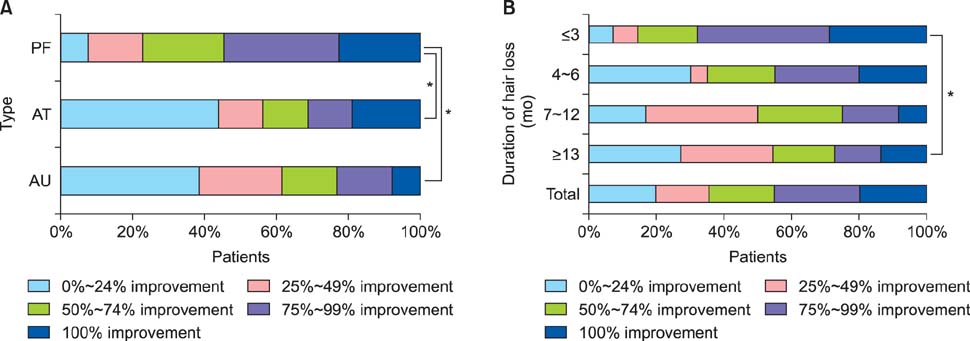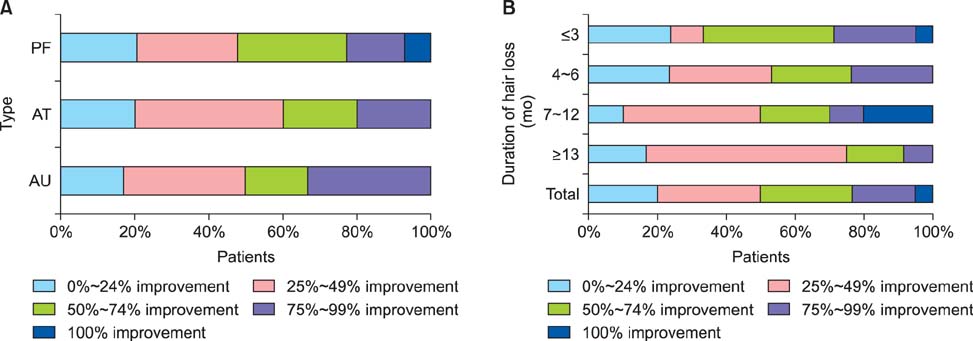Ann Dermatol.
2015 Dec;27(6):676-681. 10.5021/ad.2015.27.6.676.
Comparison of High-Dose Corticosteroid Pulse Therapy and Combination Therapy Using Oral Cyclosporine with Low-Dose Corticosteroid in Severe Alopecia Areata
- Affiliations
-
- 1Department of Dermatology, Chung-Ang University College of Medicine, Seoul, Korea. hongck@cau.ac.kr
- 2Theme Skin Clinic, Seoul, Korea.
- KMID: 2157442
- DOI: http://doi.org/10.5021/ad.2015.27.6.676
Abstract
- BACKGROUND
Severe alopecia areata (AA) is resistant to conventional treatment. Although systemic oral corticosteroids are an effective treatment for patients with severe AA, those drugs have many adverse effects. Corticosteroid pulse therapy has been introduced to increase therapeutic effects and reduce adverse effects. However, the treatment modality in severe AA is still controversial.
OBJECTIVE
To evaluate the effectiveness of corticosteroid pulse therapy in patients with severe AA compared with treatment with oral cyclosporine with corticosteroid.
METHODS
A total of 82 patients with severe AA were treated with corticosteroid pulse therapy, and 60 patients were treated with oral cyclosporine with corticosteroid. Both groups were retrospectively evaluated for therapeutic efficacy according to AA type and disease duration.
RESULTS
In 82 patients treated with corticosteroid pulse therapy, 53 (64.6%) were good responders (>50% hair regrowth). Patients with the plurifocal (PF) type of AA and those with a short disease duration (< or =3 months) showed better responses. In 60 patients treated with oral cyclosporine with corticosteroid, 30 (50.0%) patients showed a good response. The AA type or disease duration, however, did not significantly affect the response to treatment.
CONCLUSION
Corticosteroid pulse therapy may be a better treatment option than combination therapy in severe AA patients with the PF type.
Keyword
MeSH Terms
Figure
Cited by 1 articles
-
Low-Dose Systemic Methotrexate Therapy for Recalcitrant Alopecia Areata
Seul-Ki Lim, Cho-Ah Lim, In Sun Kwon, Myung Im, Young-Joon Seo, Chang-Deok Kim, Jeung-Hoon Lee, Young Lee
Ann Dermatol. 2017;29(3):263-267. doi: 10.5021/ad.2017.29.3.263.
Reference
-
1. Safavi K. Prevalence of alopecia areata in the First National Health and Nutrition Examination Survey. Arch Dermatol. 1992; 128:702.
Article2. Price VH. Alopecia areata: clinical aspects. J Invest Dermatol. 1991; 96:68S.
Article3. Shapiro J. Alopecia areata. Update on therapy. Dermatol Clin. 1993; 11:35–46.4. MacDonald Hull SP, Wood ML, Hutchinson PE, Sladden M, Messenger AG. British Association of Dermatologists. Guidelines for the management of alopecia areata. Br J Dermatol. 2003; 149:692–699.
Article5. Fiedler VC. Alopecia areata. A review of therapy, efficacy, safety, and mechanism. Arch Dermatol. 1992; 128:1519–1529.
Article6. Lebwohl M. New treatments for alopecia areata. Lancet. 1997; 349:222–223.
Article7. Madani S, Shapiro J. Alopecia areata update. J Am Acad Dermatol. 2000; 42:549–566.
Article8. Winter RJ, Kern F, Blizzard RM. Prednisone therapy for alopecia areata. A follow-up report. Arch Dermatol. 1976; 112:1549–1552.
Article9. Burton JL, Shuster S. Large doses of glucocorticoid in the treatment of alopecia areata. Acta Derm Venereol. 1975; 55:493–496.10. Kahan BD. Cyclosporine. N Engl J Med. 1989; 321:1725–1738.
Article11. Taylor M, Ashcroft AT, Messenger AG. Cyclosporin A prolongs human hair growth in vitro. J Invest Dermatol. 1993; 100:237–239.
Article12. Gupta AK, Ellis CN, Nickoloff BJ, Goldfarb MT, Ho VC, Rocher LL, et al. Oral cyclosporine in the treatment of inflammatory and noninflammatory dermatoses. A clinical and immunopathologic analysis. Arch Dermatol. 1990; 126:339–350.
Article13. Kim BJ, Min SU, Park KY, Choi JW, Park SW, Youn SW, et al. Combination therapy of cyclosporine and methylprednisolone on severe alopecia areata. J Dermatolog Treat. 2008; 19:216–220.
Article14. Shapiro J, Lui H, Tron V, Ho V. Systemic cyclosporine and low-dose prednisone in the treatment of chronic severe alopecia areata: a clinical and immunopathologic evaluation. J Am Acad Dermatol. 1997; 36:114–117.
Article15. Friedli A, Labarthe MP, Engelhardt E, Feldmann R, Salomon D, Saurat JH. Pulse methylprednisolone therapy for severe alopecia areata: an open prospective study of 45 patients. J Am Acad Dermatol. 1998; 39:597–602.
Article16. Seiter S, Ugurel S, Tilgen W, Reinhold U. High-dose pulse corticosteroid therapy in the treatment of severe alopecia areata. Dermatology. 2001; 202:230–234.
Article17. Lu W, Shapiro J, Yu M, Barekatain A, Lo B, Finner A, et al. Alopecia areata: pathogenesis and potential for therapy. Expert Rev Mol Med. 2006; 8:1–19.
Article18. McElwee KJ, Tobin DJ, Bystryn JC, King LE Jr, Sundberg JP. Alopecia areata: an autoimmune disease. Exp Dermatol. 1999; 8:371–379.
Article19. Buttgereit F, Wehling M, Burmester GR. A new hypothesis of modular glucocorticoid actions: steroid treatment of rheumatic diseases revisited. Arthritis Rheum. 1998; 41:761–767.
Article20. Im M, Lee SS, Lee Y, Kim CD, Seo YJ, Lee JH, et al. Prognostic factors in methylprednisolone pulse therapy for alopecia areata. J Dermatol. 2011; 38:767–772.
Article21. Nakajima T, Inui S, Itami S. Pulse corticosteroid therapy for alopecia areata: study of 139 patients. Dermatology. 2007; 215:320–324.
Article22. Assouly P, Reygagne P, Jouanique C, Matard B, Marechal E, Reynert P, et al. Intravenous pulse methylprednisolone therapy for severe alopecia areata: an open study of 66 patients. Ann Dermatol Venereol. 2003; 130:326–330.23. Ferron GM, Pyszczynski NA, Jusko WJ. Gender-related assessment of cyclosporine/prednisolone/sirolimus interactions in three human lymphocyte proliferation assays. Transplantation. 1998; 65:1203–1209.
Article24. Teshima H, Urabe A, Irie M, Nakagawa T, Nakayama J, Hori Y. Alopecia universalis treated with oral cyclosporine A and prednisolone: immunologic studies. Int J Dermatol. 1992; 31:513–516.
Article25. Tsai YM, Chen W, Hsu ML, Lin TK. High-dose steroid pulse therapy for the treatment of severe alopecia areata. J Formos Med Assoc. 2002; 101:223–226.
- Full Text Links
- Actions
-
Cited
- CITED
-
- Close
- Share
- Similar articles
-
- Comparison of Therapeutic Effect of High Dose Corticosteroid Pulse Therapy and Combination Therapy of Cyclosporine with Low Does Corticosteroid for Severe Alopecia Areata
- Treatment of Severe Alopecia Areata: Combination Therapy Using Systemic Cyclosporine A with Low Dose Corticosteroids
- A Case of Alopecia Areata in a Patient taking Cyclosporine
- Effect of Methyl - Prednisolone Pulse Therapy on Alopecia Totalis
- Cyclosporine Combination Therapy in Alopecia Areata




